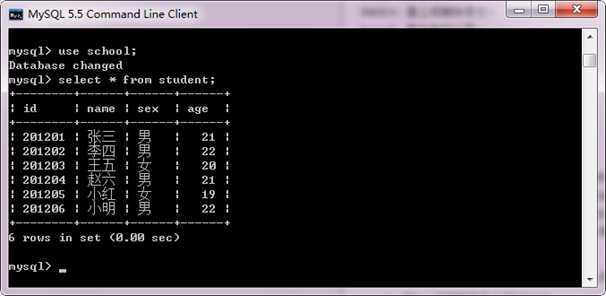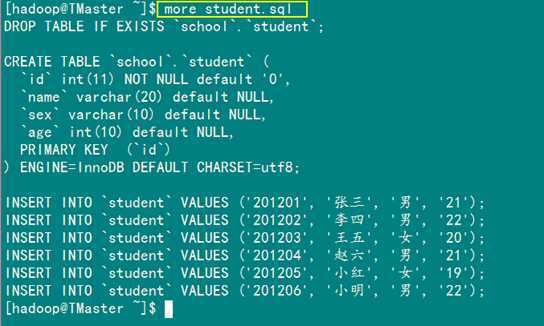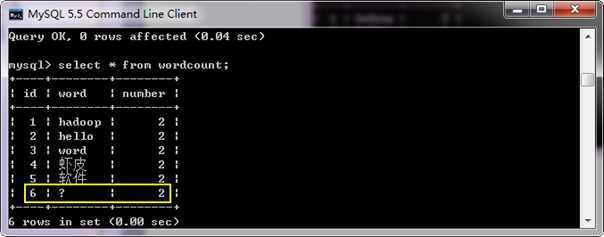标签:
MapReduce技术推出后,曾遭到关系数据库研究者的挑剔和批评,认为MapReduce不具备有类似于关系数据库中的结构化数据存储和处理能力。为此,Google和MapReduce社区进行了很多努力。一方面,他们设计了类似于关系数据中结构化数据表的技术(Google的BigTable,Hadoop的HBase)提供一些粗粒度的结构化数据存储和处理能力;另一方面,为了增强与关系数据库的集成能力,Hadoop MapReduce提供了相应的访问关系数据库库的编程接口。
MapReduce与MySQL交互的整体架构如下图所示。

图2-1整个环境的架构
具体到MapReduce框架读/写数据库,有2个主要的程序分别是 DBInputFormat和DBOutputFormat,DBInputFormat 对应的是SQL语句select,而DBOutputFormat 对应的是 Inster/update,使用DBInputFormat和DBOutputForma时候需要实现InputFormat这个抽象类,这个抽象类含有getSplits()和createRecordReader()抽象方法,在DBInputFormat类中由 protected String getCountQuery() 方法传入结果集的个数,getSplits()方法再确定输入的切分原则,利用SQL中的 LIMIT 和 OFFSET 进行切分获得数据集的范围 ,请参考DBInputFormat源码中public InputSplit[] getSplits(JobConf job, int chunks) throws IOException的方法,在DBInputFormat源码中createRecordReader()则可以按一定格式读取相应数据。
1)建立关系数据库连接
DBConfiguration类中提供了一个静态方法创建数据库连接:
public static void configureDB(Job job,String driverClass,String dbUrl,String userName,String Password)
其中,job为当前准备执行的作业,driverClasss为数据库厂商提供的访问其数据库的驱动程序,dbUrl为运行数据库的主机的地址,userName和password分别为数据库提供访问地用户名和相应的访问密码。
2)相应的从关系数据库查询和读取数据的接口
3)相应的向关系数据库直接输出结果的编程接口
数据库连接完成后,即可完成从MapReduce程序向关系数据库写入数据的操作。为了告知数据库将写入哪个表中的哪些字段,DBOutputFormat中提供了一个静态方法来指定需要写入的数据表和字段:
public static void setOutput(Job job,String tableName,String ... fieldName)
其中,tableName指定即将写入的数据表,后续参数将指定哪些字段数据将写入该表。
虽然Hadoop允许从数据库中直接读取数据记录作为MapReduce的输入,但处理效率较低,而且大量频繁地从MapReduce程序中查询和读取关系数据库可能会大大增加数据库的访问负载,因此DBInputFormat仅适合读取小量数据记录的计算和应用,不适合数据仓库联机数据分析大量数据的读取处理。
读取大量数据记录一个更好的解决办法是:用数据库中的Dump工具将大量待分析数据输出为文本数据文件,并上载到HDFS中进行处理。
1)首先创建要读入的数据
首先创建数据库"school",使用下面命令进行:
create database school;

然后通过以下几句话,把我们事先准备好的sql语句(student.sql事先放到了D盘目录)导入到刚创建的"school"数据库中。用到的命令如下:
use school;
source d:\student.sql
"student.sql"中的内容如下所示:
DROP TABLE IF EXISTS `school`.`student`;
CREATE TABLE `school`.`student` (
`id` int(11) NOT NULL default ‘0‘,
`name` varchar(20) default NULL,
`sex` varchar(10) default NULL,
`age` int(10) default NULL,
PRIMARY KEY (`id`)
) ENGINE=InnoDB DEFAULT CHARSET=utf8;
INSERT INTO `student` VALUES (‘201201‘, ‘张三‘, ‘男‘, ‘21‘);
INSERT INTO `student` VALUES (‘201202‘, ‘李四‘, ‘男‘, ‘22‘);
INSERT INTO `student` VALUES (‘201203‘, ‘王五‘, ‘女‘, ‘20‘);
INSERT INTO `student` VALUES (‘201204‘, ‘赵六‘, ‘男‘, ‘21‘);
INSERT INTO `student` VALUES (‘201205‘, ‘小红‘, ‘女‘, ‘19‘);
INSERT INTO `student` VALUES (‘201206‘, ‘小明‘, ‘男‘, ‘22‘);
执行结果如下所示:

查询刚才创建的数据库表"student"的内容。

结果发现显示是乱码,记得我当时是设置的UTF-8,怎么就出现乱码了呢?其实我们使用的操作系统的系统为中文,且它的默认编码是gbk,而MySQL的编码有两种,它们分别是:
【client】:客户端的字符集。客户端默认字符集。当客户端向服务器发送请求时,请求以该字符集进行编码。
【mysqld】:服务器字符集,默认情况下所采用的。
找到安装MySQL目录,比如我们的安装目录为:
E:\HadoopWorkPlat\MySQL Server 5.5
从中找到"my.ini"配置文件,最终发现my.ini里的2个character_set把client改成gbk,把server改成utf8就可以了。
【client】端:
[client]
port=3306
[mysql]
default-character-set=gbk
【mysqld】端:
[mysqld]
# The default character set that will be used when a new schema or table is
# created and no character set is defined
character-set-server=utf8
按照上面修改完之后,重启MySQL服务。

此时在Windows下面的数据库表已经准备完成了。
首先通过"FlashFXP"把我们刚才的"student.sql"上传到"/home/hadoop"目录下面,然后按照上面的语句创建"school"数据库。

查看我们上传的"student.sql"内容:

创建"school"数据库,并导入"student.sql"语句。

显示数据库"school"中的表"student"信息。

显示表"student"中的内容。

到此为止在"Windows"和"Linux"两种环境下面都创建了表"student"表,并初始化了值。下面就开始通过MapReduce读取MySQL库中表"student"的信息。
2)使MySQL能远程连接
MySQL默认是允许别的机器进行远程访问地,为了使Hadoop集群能访问MySQL数据库,所以进行下面操作。
mysql -u root -p
GRANT ALL PRIVILEGES ON *.* TO ‘root‘@‘%‘ IDENTIFIED BY ‘hadoop‘ WITH GRANT OPTION;
FLUSH PRIVILEGES;
执行结果如下图。
Windows下面:

Linux下面:

到目前为止,如果连接Win7上面的MySQL数据库还不行,大家还应该记得前面在Linux下面关掉了防火墙,但是我们在Win7下对防火墙并没有做任何处理,如果不对防火墙做处理,即使执行了上面的远程授权,仍然不能连接。下面是设置Win7上面的防火墙,使远程机器能通过3306端口访问MySQL数据库。
解决方案:只要在‘入站规则‘上建立一个3306端口即可。
执行顺序:控制面板à管理工具à高级安全的Windows防火墙à入站规则
然后新建规则à选择‘端口‘à在‘特定本地端口‘上输入一个‘3306‘ à选择‘允许连接‘=>选择‘域‘、‘专用‘、‘公用‘=>给个名称,如:MySqlInput

3)对JDBC的Jar包处理
因为程序虽然用Eclipse编译运行但最终要提交到Hadoop集群上,所以JDBC的jar必须放到Hadoop集群中。有两种方式:
(1)在每个节点下的${HADOOP_HOME}/lib下添加该包,重启集群,一般是比较原始的方法。
我们的Hadoop安装包在"/usr/hadoop",所以把Jar放到"/usr/hadoop/lib"下面,然后重启,记得是Hadoop集群中所有的节点都要放,因为执行分布式是程序是在每个节点本地机器上进行。
(2)在Hadoop集群的分布式文件系统中创建"/lib"文件夹,并把我们的的JDBC的jar包上传上去,然后在主程序添加如下语句,就能保证Hadoop集群中所有的节点都能使用这个jar包。因为这个jar包放在了HDFS上,而不是本地系统,这个要理解清楚。
DistributedCache.addFileToClassPath(new Path("/lib/mysql-connector-java-5.1.18-bin.jar"), conf);
我们用的JDBC的jar如下所示:
mysql-connector-java-5.1.18-bin.jar
通过Eclipse下面的DFS Locations进行创建"/lib"文件夹,并上传JDBC的jar包。执行结果如下:

备注:我们这里采用了第二种方式。
4)源程序代码如下所示
package com.hebut.mr;
import java.io.IOException;
import java.io.DataInput;
import java.io.DataOutput;
import java.sql.Connection;
import java.sql.DriverManager;
import java.sql.PreparedStatement;
import java.sql.ResultSet;
import java.sql.SQLException;
import org.apache.hadoop.filecache.DistributedCache;
import org.apache.hadoop.fs.Path;
import org.apache.hadoop.io.LongWritable;
import org.apache.hadoop.io.Text;
import org.apache.hadoop.io.Writable;
import org.apache.hadoop.mapred.JobClient;
import org.apache.hadoop.mapred.JobConf;
import org.apache.hadoop.mapred.MapReduceBase;
import org.apache.hadoop.mapred.Mapper;
import org.apache.hadoop.mapred.OutputCollector;
import org.apache.hadoop.mapred.FileOutputFormat;
import org.apache.hadoop.mapred.Reporter;
import org.apache.hadoop.mapred.lib.IdentityReducer;
import org.apache.hadoop.mapred.lib.db.DBWritable;
import org.apache.hadoop.mapred.lib.db.DBInputFormat;
import org.apache.hadoop.mapred.lib.db.DBConfiguration;
public class ReadDB {
public static class Map extends MapReduceBase implements
Mapper<LongWritable, StudentRecord, LongWritable, Text> {
// 实现map函数
public void map(LongWritable key, StudentRecord value,
OutputCollector<LongWritable, Text> collector, Reporter reporter)
throws IOException {
collector.collect(new LongWritable(value.id),
new Text(value.toString()));
}
}
public static class StudentRecord implements Writable, DBWritable {
public int id;
public String name;
public String sex;
public int age;
@Override
public void readFields(DataInput in) throws IOException {
this.id = in.readInt();
this.name = Text.readString(in);
this.sex = Text.readString(in);
this.age = in.readInt();
}
@Override
public void write(DataOutput out) throws IOException {
out.writeInt(this.id);
Text.writeString(out, this.name);
Text.writeString(out, this.sex);
out.writeInt(this.age);
}
@Override
public void readFields(ResultSet result) throws SQLException {
this.id = result.getInt(1);
this.name = result.getString(2);
this.sex = result.getString(3);
this.age = result.getInt(4);
}
@Override
public void write(PreparedStatement stmt) throws SQLException {
stmt.setInt(1, this.id);
stmt.setString(2, this.name);
stmt.setString(3, this.sex);
stmt.setInt(4, this.age);
}
@Override
public String toString() {
return new String("学号:" + this.id + "_姓名:" + this.name
+ "_性别:"+ this.sex + "_年龄:" + this.age);
}
}
public static void main(String[] args) throws Exception {
JobConf conf = new JobConf(ReadDB.class);
// 这句话很关键
conf.set("mapred.job.tracker", "192.168.1.2:9001");
// 非常重要,值得关注
DistributedCache.addFileToClassPath(new Path(
"/lib/mysql-connector-java-5.1.18-bin.jar"), conf);
// 设置输入类型
conf.setInputFormat(DBInputFormat.class);
// 设置输出类型
conf.setOutputKeyClass(LongWritable.class);
conf.setOutputValueClass(Text.class);
// 设置Map和Reduce类
conf.setMapperClass(Map.class);
conf.setReducerClass(IdentityReducer.class);
// 设置输出目录
FileOutputFormat.setOutputPath(conf, new Path("rdb_out"));
// 建立数据库连接
DBConfiguration.configureDB(conf, "com.mysql.jdbc.Driver",
"jdbc:mysql://192.168.1.24:3306/school", "root", "hadoop");
// 读取"student"表中的数据
String[] fields = { "id", "name", "sex", "age" };
DBInputFormat.setInput(conf, StudentRecord.class, "student", null,"id", fields);
JobClient.runJob(conf);
}
}
备注:由于Hadoop1.0.0新的API对关系型数据库暂不支持,只能用旧的API进行,所以下面的"向数据库中输出数据"也是如此。
5)运行结果如下所示
经过上面的设置后,已经通过连接Win7和Linux上的MySQL数据库,执行结果都一样。唯独变得就是代码中"DBConfiguration.configureDB"中MySQL数据库所在机器的IP地址。

基于数据仓库的数据分析和挖掘输出结果的数据量一般不会太大,因而可能适合于直接向数据库写入。我们这里尝试与"WordCount"程序相结合,把单词统计的结果存入到关系型数据库中。
1)创建写入的数据库表
我们还使用刚才创建的数据库"school",只是在里添加一个新的表"wordcount",还是使用下面语句执行:
use school;
source sql脚本全路径
下面是要创建的"wordcount"表的sql脚本。
DROP TABLE IF EXISTS `school`.`wordcount`;
CREATE TABLE `school`.`wordcount` (
`id` int(11) NOT NULL auto_increment,
`word` varchar(20) default NULL,
`number` int(11) default NULL,
PRIMARY KEY (`id`)
) ENGINE=InnoDB DEFAULT CHARSET=utf8;
执行效果如下所示:


2)程序源代码如下所示
package com.hebut.mr;
import java.io.IOException;
import java.io.DataInput;
import java.io.DataOutput;
import java.sql.PreparedStatement;
import java.sql.ResultSet;
import java.sql.SQLException;
import java.util.Iterator;
import java.util.StringTokenizer;
import org.apache.hadoop.filecache.DistributedCache;
import org.apache.hadoop.fs.Path;
import org.apache.hadoop.io.IntWritable;
import org.apache.hadoop.io.Text;
import org.apache.hadoop.io.Writable;
import org.apache.hadoop.mapred.FileInputFormat;
import org.apache.hadoop.mapred.JobClient;
import org.apache.hadoop.mapred.JobConf;
import org.apache.hadoop.mapred.MapReduceBase;
import org.apache.hadoop.mapred.Mapper;
import org.apache.hadoop.mapred.OutputCollector;
import org.apache.hadoop.mapred.Reducer;
import org.apache.hadoop.mapred.Reporter;
import org.apache.hadoop.mapred.TextInputFormat;
import org.apache.hadoop.mapred.lib.db.DBOutputFormat;
import org.apache.hadoop.mapred.lib.db.DBWritable;
import org.apache.hadoop.mapred.lib.db.DBConfiguration;
public class WriteDB {
// Map处理过程
public static class Map extends MapReduceBase implements
Mapper<Object, Text, Text, IntWritable> {
private final static IntWritable one = new IntWritable(1);
private Text word = new Text();
@Override
public void map(Object key, Text value,
OutputCollector<Text, IntWritable> output, Reporter reporter)
throws IOException {
String line = value.toString();
StringTokenizer tokenizer = new StringTokenizer(line);
while (tokenizer.hasMoreTokens()) {
word.set(tokenizer.nextToken());
output.collect(word, one);
}
}
}
// Combine处理过程
public static class Combine extends MapReduceBase implements
Reducer<Text, IntWritable, Text, IntWritable> {
@Override
public void reduce(Text key, Iterator<IntWritable> values,
OutputCollector<Text, IntWritable> output, Reporter reporter)
throws IOException {
int sum = 0;
while (values.hasNext()) {
sum += values.next().get();
}
output.collect(key, new IntWritable(sum));
}
}
// Reduce处理过程
public static class Reduce extends MapReduceBase implements
Reducer<Text, IntWritable, WordRecord, Text> {
@Override
public void reduce(Text key, Iterator<IntWritable> values,
OutputCollector<WordRecord, Text> collector, Reporter reporter)
throws IOException {
int sum = 0;
while (values.hasNext()) {
sum += values.next().get();
}
WordRecord wordcount = new WordRecord();
wordcount.word = key.toString();
wordcount.number = sum;
collector.collect(wordcount, new Text());
}
}
public static class WordRecord implements Writable, DBWritable {
public String word;
public int number;
@Override
public void readFields(DataInput in) throws IOException {
this.word = Text.readString(in);
this.number = in.readInt();
}
@Override
public void write(DataOutput out) throws IOException {
Text.writeString(out, this.word);
out.writeInt(this.number);
}
@Override
public void readFields(ResultSet result) throws SQLException {
this.word = result.getString(1);
this.number = result.getInt(2);
}
@Override
public void write(PreparedStatement stmt) throws SQLException {
stmt.setString(1, this.word);
stmt.setInt(2, this.number);
}
}
public static void main(String[] args) throws Exception {
JobConf conf = new JobConf(WriteDB.class);
// 这句话很关键
conf.set("mapred.job.tracker", "192.168.1.2:9001");
DistributedCache.addFileToClassPath(new Path(
"/lib/mysql-connector-java-5.1.18-bin.jar"), conf);
// 设置输入输出类型
conf.setInputFormat(TextInputFormat.class);
conf.setOutputFormat(DBOutputFormat.class);
// 不加这两句,通不过,但是网上给的例子没有这两句。
conf.setOutputKeyClass(Text.class);
conf.setOutputValueClass(IntWritable.class);
// 设置Map和Reduce类
conf.setMapperClass(Map.class);
conf.setCombinerClass(Combine.class);
conf.setReducerClass(Reduce.class);
// 设置输如目录
FileInputFormat.setInputPaths(conf, new Path("wdb_in"));
// 建立数据库连接
DBConfiguration.configureDB(conf, "com.mysql.jdbc.Driver",
"jdbc:mysql://192.168.1.24:3306/school", "root", "hadoop");
// 写入"wordcount"表中的数据
String[] fields = { "word", "number" };
DBOutputFormat.setOutput(conf, "wordcount", fields);
JobClient.runJob(conf);
}
}
3)运行结果如下所示
测试数据:
(1)file1.txt
hello word
hello hadoop
(2)file2.txt
虾皮 hadoop
虾皮 word
软件 软件
运行结果:

我们发现上图中出现了"?",后来查找原来是因为我的测试数据时在Windows用记事本写的然后保存为"UTF-8",在保存时为了区分编码,自动在前面加了一个"BOM",但是不会显示任何结果。然而我们的代码把它识别为"?"进行处理。这就出现了上面的结果,如果我们在每个要处理的文件前面的第一行加一个空格,结果就成如下显示:

接着又做了一个测试,在Linux上面用下面命令创建了一个文件,并写上中文内容。结果显示并没有出现"?",而且网上说不同的记事本软件(EmEditor、UE)保存为"UTF-8"就没有这个问题。经过修改之后的Map类,就能够正常识别了。
// Map处理过程
public static class Map extends MapReduceBase implements
Mapper<Object, Text, Text, IntWritable> {
private final static IntWritable one = new IntWritable(1);
private Text word = new Text();
@Override
public void map(Object key, Text value,
OutputCollector<Text, IntWritable> output, Reporter reporter)
throws IOException {
String line = value.toString();
//处理记事本UTF-8的BOM问题
if (line.getBytes().length > 0) {
if ((int) line.charAt(0) == 65279) {
line = line.substring(1);
}
}
StringTokenizer tokenizer = new StringTokenizer(line);
while (tokenizer.hasMoreTokens()) {
word.set(tokenizer.nextToken());
output.collect(word, one);
}
}
}
处理之后的结果:

从上图中得知,我们的问题已经解决了,因此,在编辑、更改任何文本文件时,请务必使用不会乱加BOM的编辑器。Linux下的编辑器应该都没有这个问题。Windows下,请勿使用记事本等编辑器。推荐的编辑器是: Editplus 2.12版本以上; EmEditor; UltraEdit(需要取消‘添加BOM‘的相关选项); Dreamweaver(需要取消‘添加BOM‘的相关选项) 等。
对于已经添加了BOM的文件,要取消的话,可以用以上编辑器另存一次。(Editplus需要先另存为gb,再另存为UTF-8。) DW解决办法如下: 用DW打开指定文件,按Ctrl+Jà标题/编码à编码选择"UTF-8",去掉"包括Unicode签名(BOM)"勾选à保存/另存为,即可。
国外有一个牛人已经把这个问题解决了,使用"UnicodeInputStream"、"UnicodeReader"。
地址:http://koti.mbnet.fi/akini/java/unicodereader/
示例:Java读带有BOM的UTF-8文件乱码原因及解决方法
代码:http://download.csdn.net/detail/xia520pi/4146123
测试数据:
(1)file1.txt
MapReduce is simple
(2)file2.txt
MapReduce is powerful is simple
(3)file2.txt
Hello MapReduce bye MapReduce
运行结果:

到目前为止,MapReduce与关系型数据库交互已经结束,从结果中得知,目前新版的API还不能很好的支持关系型数据库的操作,上面两个例子都是使用的旧版的API。关于更多的MySQL操作,具体参考"Hadoop集群_第10期副刊_常用MySQL数据库命令_V1.0"。
本期历时五天,终于完成,期间遇到的关键问题如下:
从这几天对MapReduce的了解,发现其实Hadoop对关系型数据库的处理还不是很强,主要是Hadoop和关系型数据做的事不是同一类型,各有所特长。下面几期我们将对Hadoop里的HBase和Hive进行全面了解。
Hadoop集群(第10期)_MapReduce与MySQL交互
标签:
原文地址:http://www.cnblogs.com/x113/p/4181223.html